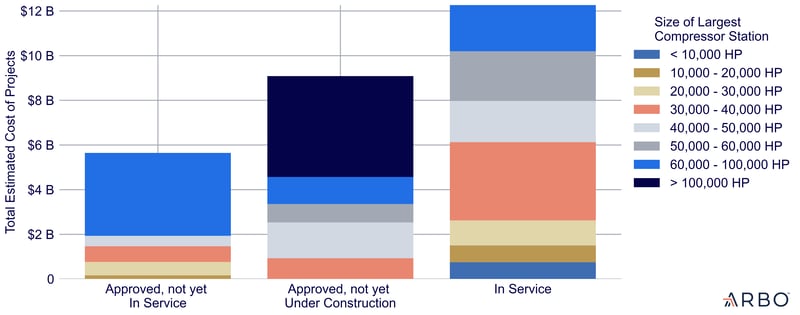What’s the issue?
At last week’s open meeting, FERC opened an inquiry into the certificate it had previously granted to Algonquin’s Atlantic Bridge project.
Why does it matter?
Once a certificate has been issued and the appeal period for that order has expired, FERC has in the past respected the finality of its decision, but the inquiry launched last week completely rejects that long-held standard.
What’s our view?
Given the polarized nature of the country’s politics, the fact that FERC believes it can revisit and revise all previous final orders creates a substantial risk for the industry. While the specific inquiry concerns a single project, the entire industry is likely to weigh in on this radical departure from FERC precedent.
At last week’s open meeting, FERC issued a two-page order that generated 18 pages of separate dissents by Commissioners Danly and Christie. Commissioner Danly also pleaded with the entire industry to take note of this order and to provide FERC with comments in response. While the order was issued in a proceeding involving Algonquin’s Atlantic Bridge project, the dissents are correct in noting the radical nature of the order and how it could impact the entire industry. As we discuss more thoroughly below, the order creates an entirely new risk to projects in that a majority of FERC commissioners appears to believe that FERC can revoke a completed project’s certificate without any enforcement action or even a determination that the certificate was violated.
Background of the Atlantic Bridge Project
The Atlantic Bridge project is a relatively small project that is currently providing an additional 239,000 dth/day of capacity into the gas-constrained New England market. Because of its location, however, the project is not inexpensive, with an original estimated cost of $450 million. The project involved very distinct components that worked together with Algonquin’s existing system to provide the incremental capacity. It included four miles of replacement pipeline in Westchester County, New York, the densely populated county just to the north of Manhattan, and 2.3 miles of replacement pipeline in Fairfield County, Connecticut, which is also densely populated. The project also involved modifications to three existing compressor stations and the addition of one new compressor station, a relatively small 7,700 horsepower one, in Weymouth, Massachusetts, just outside of Boston. It is this last component that created all of the issues at FERC and which ultimately led to the issuance of the unprecedented order last week.
FERC issued the project its certificate on January 25, 2017, which was during the period when there were only three Democratic commissioners, and one of them, Chairman Bay, was about to step down, leaving FERC without a quorum, following his demotion by President Trump. The certificate was appealed to the U.S. Court of Appeals for the District of Columbia Circuit (DC Circuit) which upheld the FERC certificate on December 27, 2018. The court found so little in the merits of the opponents’ claims that it rejected the appeal through a per curiam order, i.e., an abbreviated decision endorsed by the entire panel of judges that considered the appeal.
In the meantime, while the appeal process was proceeding, FERC authorized the construction of the various facilities as Algonquin received the necessary permits for each one, and authorized the facilities to go into service as construction was completed. The various portions of the project were placed into service in June 2017, October 2017, September 2018 and September 2019. In September 2020, FERC granted the pipeline authority to place the final facility into service, the 7,700 hp Weymouth Compressor Station. While it was commissioning the Weymouth Compressor Station, Algonquin had two separate incidents where the emergency shutdown system at the station activated. This led to the release of gas from the station and also led to the Pipeline and Hazardous Materials Safety Administration (PHMSA) issuing a corrective action order that delayed the in-service date of the station. On November 20, PHMSA approved the restart plan for the station, and exactly four years to the day since FERC issued the certificate, on January 25, 2021, Algonquin notified FERC that the station was in-service.
FERC’s Order From Last Week
Despite the fact that FERC had approved every aspect of the project, at last week’s open meeting, Chairman Glick, joined by Commissioners Clements and Chatterjee, issued an order that asks the parties to the proceeding to provide briefs on four topics:
- Whether to allow the station to remain in service given “concerns expressed regarding public safety;"
- Reconsider the current operation of the station due to any changed circumstances since it was authorized, such as changes in the station’s projected air emissions impacts, or public safety impacts, or its impacts on environmental justice communities;
- Additional mitigation measures the Commission should impose in response to air emissions or public safety concerns;
- Consequences from staying or reversing the order authorizing the station to go into service.
All of these issues were addressed at the time FERC issued the certificate. In fact, many of the same topics were summarily dismissed by the DC Circuit in its very brief order. That order noted that FERC had considered every safety risk that the challengers had identified, that FERC properly determined that the project served the public convenience and necessity even though half of its gas was slated for export to Canada, and that FERC had adequately analyzed all environmental impacts, including from coal ash, noise, traffic, greenhouse-gas emissions, and the project’s effects on environmental justice communities. With regard to this environmental justice concern, the court found that FERC was reasonable in concluding that the project would not disproportionately affect environmental justice communities around Weymouth because the compressor station’s effects would be similar to those experienced by non-environmental-justice communities surrounding the three existing stations being expanded by the project.
Risk to the Industry from the Order is Massive
While the order FERC issued purports to be about one compressor station on one project, the mere fact that FERC is going down this path opens the industry up to a substantial new risk that it has never had to face. The Atlantic Bridge certificate order was final a long time ago and was no longer subject to appeal in the courts since early in 2019. In addition, this compressor station in question is a very small one, rated at only 7,700 horsepower. In looking at the projects that received their certificate after Atlantic Bridge and have a compressor station of at least 7,700 horsepower, the estimated cost of similarly situated projects is huge.

As seen above, there are projects that have been placed into service, like Atlantic Bridge, that were estimated to cost more than $12 billion, another almost $6 billion in projects are under construction, and another $9 billion has been approved but construction has not yet started. As properly noted in Commissioner Danly’s dissent, even raising these questions at this point in a proceeding creates a risk that “even if a pipeline has its certificate, a court upholds that certificate and that pipeline is in compliance, the Commission can now find a way to modify, or even possibly revoke, the certificate.” Further, as Commissioner Christie notes in his dissent, the majority of commissioners have invited the project’s opponents “to re-litigate the core question of whether the project should even have been built.”
The order appears to use the issuance of a routine delegated order by FERC staff on September 24, 2020 as the hook for this extraordinary and unprecedented reopening of the entire case. This order authorized the Weymouth compressor station to go into service. However, as indicated above, this was not the only such order issued by staff in this case. There were four others and all five of these orders were based on the single finding required by the FERC certificate order in this case, and in all cases decided before it or since -- namely that FERC staff had determined that “rehabilitation and restoration of the right-of-way and other areas affected by the Project are proceeding satisfactorily.” As in all certificate orders, at the point of placing a project into service, that is the only issue that is open for debate and consideration.
By opening the door to relitigate the entire case, based simply on “concerns,” Commissioner Christie properly notes in his dissent that the majority “may, regrettably, impact investment in all infrastructure projects making them less appealing to engage in by those who normally seek to build the projects and harder to finance or, at the very least, more expensive to finance due to the increased risk created by this specter of uncertainty.” (Emphasis in original.) Perhaps this is, in fact, the goal of the majority, but as Commissioner Christie notes, the use of “unending litigation and collateral attacks” long after a project has been approved, as is enabled by the majority, “will not be limited to natural gas projects, even though they are today’s primary target. Campaigns of unending legal warfare may well be used one day against other types of infrastructure projects, including those the majority may well want to promote.”
FERC directed that initial briefs be filed by April 5 and that all reply briefs be filed by May 5. While, clearly, Algonquin will need to respond, we expect that it will not be alone because, as shown by the graphic above, there is at least another $25 billion in projects with a vested interest in the outcome. As Commissioner Christie properly notes in his dissent, “all” of the industry may very well be imperiled by this order.


